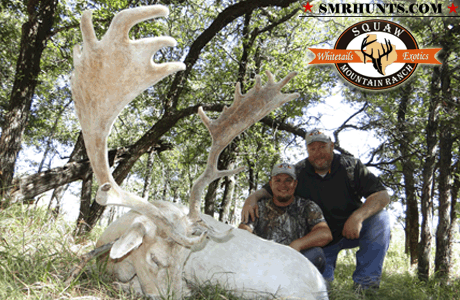
Fallow deer were introduced to Britain from the Mediterranean during Roman times. These fallow deer became extinct in Britain following the Roman Empire’s collapse and the decline of fallow deer habitat but were later reintroduced in the 11th century.
Originally they were held in parks and treated as rare exotic animals. Eventually their populations grew as they became an vital source of venison for the rich. During the 15th century, many parks were no longer maintained and many deer escaped leading to the free living population of fallow deer that is found in Britain today. Fallow deer are also widely found in Scotland and the Northern Island as well as here in the United States.
In the U.S., fallow deer are widely sought after by hunters in Texas where they are the target of trophy hunts. This is mainly because of their impressive antlers which can measure up to 70 centimeters in height. Fallow deer are the only British deer with palmate antlers.
Characteristics of Fallow Deer Habitat
Fallow Deer are not fussy when it comes to where they live. They can adapt to many different types of settings. That’s why you’ll find them in forests, shrub lands, grasslands, pasturelands, and plantations. Typically fallow deer habitat is of the mixed vegetation type. They also tend to lean towards habitats that are broad-leaf forests with different levels of density. Fallow deer can also live in a variety of climates ranging from cool-humid areas to warm-dry areas. They are also known to call meadows and marshes home.
Fallow deer habitat can vary greatly. They aren’t fussy, they simply base their home on where they can find food. Fallow deer tend to live only in areas where they can find enough food in the summer and can still survive in the winter with whatever is at their disposal. This is why they search for dense areas. Grasses provide nearly 60% of their diet as well as herbs. During the fall they will also look for acorns, chestnut, beech mast and fruits. If those are not available they will eat bramble and conifer.
Fallow deer are known to cause a good amount of damage where they live by feeding on buds and leaves. They are also known to strip bark from trees.
You can also find fallow deer in farming country. Wherever they call home you will usually find them in herds of 10-50. During the day they will take shelter in the woodlands. At night they will come out to feed on the farmland.
More about Fallow Deer Habitat
During the rut, which typically happens in October, fallow deer become territorial. This is when they will groan and defend the area where the doe will visit for mating.
While fallow deer can be found in many habitats but they often make a “home range” which is an area that is frequented more than others. You can often notice these areas because they are more heavily travelled. Although fallow deer are active around the clock, they will come out more at night in areas where there are many humans around. This way they can get food and move about without being noticed as much as they would during the day.
Climate of Fallow Deer Habitat
Just as fallow deer can be found in a variety of wooded areas, they can also be found in a variety of climates. This means the range of climates where they are found is cool to humid as well as warm and dry. This is why they can be found in various parts of Europe as well as the United States.
The climate in Texas is favorable for the fallow deer. There is a rather substantial population of fallow deer at Squaw Mountain Ranch where trophy hunts have become popular. Since there are no restrictions on hunting fallow deer in Texas, this is a year-round hobby for hunters.
